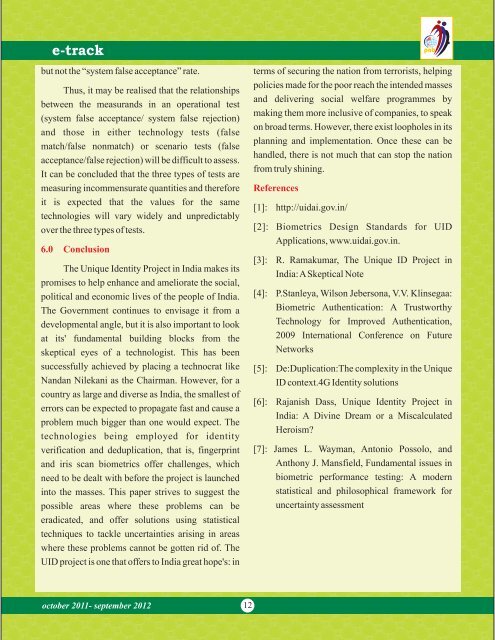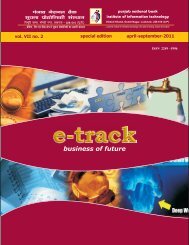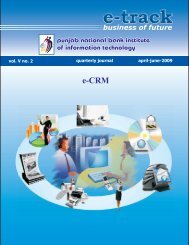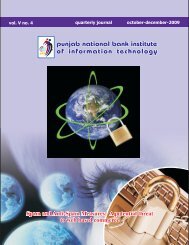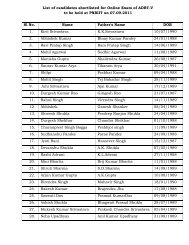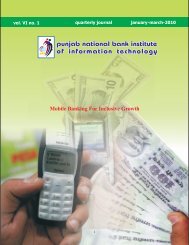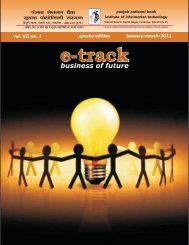Sep'12 - Punjab National Bank Institute of Information Technology
Sep'12 - Punjab National Bank Institute of Information Technology
Sep'12 - Punjab National Bank Institute of Information Technology
Create successful ePaper yourself
Turn your PDF publications into a flip-book with our unique Google optimized e-Paper software.
e-track<br />
but not the “system false acceptance” rate.<br />
Thus, it may be realised that the relationships<br />
between the measurands in an operational test<br />
(system false acceptance/ system false rejection)<br />
and those in either technology tests (false<br />
match/false nonmatch) or scenario tests (false<br />
acceptance/false rejection) will be difficult to assess.<br />
It can be concluded that the three types <strong>of</strong> tests are<br />
measuring incommensurate quantities and therefore<br />
it is expected that the values for the same<br />
technologies will vary widely and unpredictably<br />
over the three types <strong>of</strong> tests.<br />
6.0 Conclusion<br />
The Unique Identity Project in India makes its<br />
promises to help enhance and ameliorate the social,<br />
political and economic lives <strong>of</strong> the people <strong>of</strong> India.<br />
The Government continues to envisage it from a<br />
developmental angle, but it is also important to look<br />
at its' fundamental building blocks from the<br />
skeptical eyes <strong>of</strong> a technologist. This has been<br />
successfully achieved by placing a technocrat like<br />
Nandan Nilekani as the Chairman. However, for a<br />
country as large and diverse as India, the smallest <strong>of</strong><br />
errors can be expected to propagate fast and cause a<br />
problem much bigger than one would expect. The<br />
technologies being employed for identity<br />
verification and deduplication, that is, fingerprint<br />
and iris scan biometrics <strong>of</strong>fer challenges, which<br />
need to be dealt with before the project is launched<br />
into the masses. This paper strives to suggest the<br />
possible areas where these problems can be<br />
eradicated, and <strong>of</strong>fer solutions using statistical<br />
techniques to tackle uncertainties arising in areas<br />
where these problems cannot be gotten rid <strong>of</strong>. The<br />
UID project is one that <strong>of</strong>fers to India great hope's: in<br />
terms <strong>of</strong> securing the nation from terrorists, helping<br />
policies made for the poor reach the intended masses<br />
and delivering social welfare programmes by<br />
making them more inclusive <strong>of</strong> companies, to speak<br />
on broad terms. However, there exist loopholes in its<br />
planning and implementation. Once these can be<br />
handled, there is not much that can stop the nation<br />
from truly shining.<br />
References<br />
[1]: http://uidai.gov.in/<br />
[2]: Biometrics Design Standards for UID<br />
Applications, www.uidai.gov.in.<br />
[3]: R. Ramakumar, The Unique ID Project in<br />
India: A Skeptical Note<br />
[4]: P.Stanleya, Wilson Jebersona, V.V. Klinsegaa:<br />
Biometric Authentication: A Trustworthy<br />
<strong>Technology</strong> for Improved Authentication,<br />
2009 International Conference on Future<br />
Networks<br />
[5]: De:Duplication:The complexity in the Unique<br />
ID context.4G Identity solutions<br />
[6]: Rajanish Dass, Unique Identity Project in<br />
India: A Divine Dream or a Miscalculated<br />
Heroism?<br />
[7]: James L. Wayman, Antonio Possolo, and<br />
Anthony J. Mansfield, Fundamental issues in<br />
biometric performance testing: A modern<br />
statistical and philosophical framework for<br />
uncertainty assessment<br />
october 2011- september 2012<br />
12


